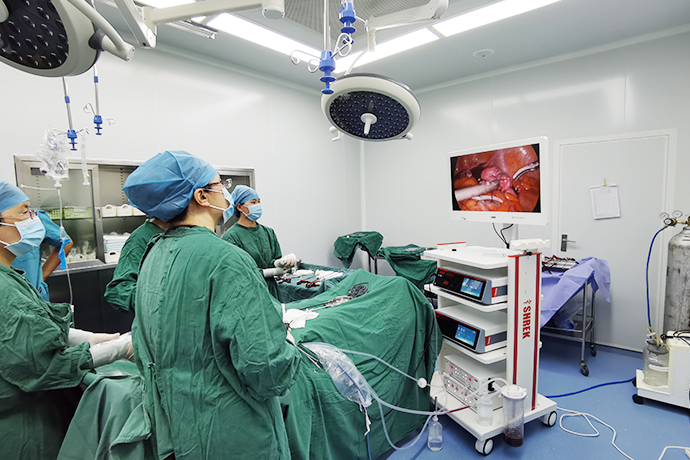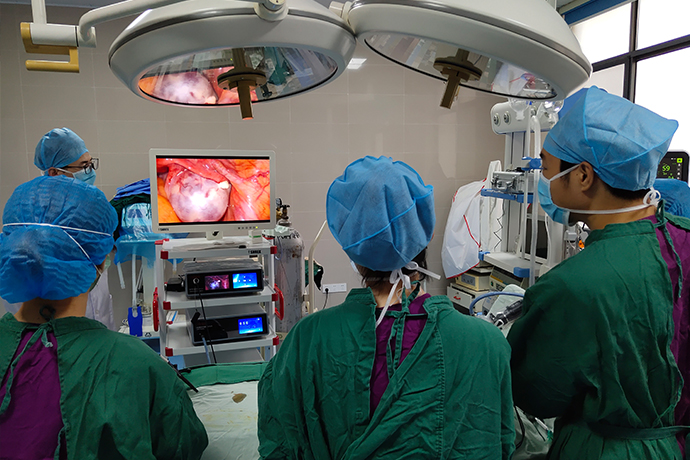[Gynecological Laparoscopy] 4K Laparoscopic Ovarian Cystectomy
Release time: 04 Jul 2023 Author:Shrek
Laparoscopic surgery is widely used in the field of gynecological surgery because of its small surgical trauma and fast postoperative recovery. Ovarian cyst is one of the common diseases in gynecology. Laparoscopic ovarian cystectomy is considered as the "golden surgery" to remove benign ovarian cysts.

Surgical indications
1. Pathological types: all types except ovarian malignant tumors, common simple cysts, follicular cysts, mesangial cysts (ovarian crown cysts), endometriotic cysts, teratoma, epithelial cystadenoma, etc.
2. Requirements for ovarian cysts
(1) The cyst should not be too large, and the diameter is less than 15cm; some people use 8cm as the boundary, but in fact 8cm is relative to teratoma, and simple cysts less than 15cm can be operated.
(2) On gynecological examination, the cyst is isolated, the cyst pedicle is long, the activity is good, and there is no adhesion.
Surgical contraindications
1. Pathological type: the cyst is suspected to be malignant or the cyst is clearly malignant before operation.
2. The cyst is too large, the adhesion around the ovary is heavy, and the proper ligament is too short.
General steps
1. The patient is supine, with the head lowered and feet higher than 15-30 degrees, the bladder lithotomy position, the uterine lifter is placed, and the urinary catheter is placed.
2. Cut the skin lcm at the upper or lower edge of the navel chakra, place a mirror (25-30 degrees), and maintain the pressure of the CO2 pneumoperitoneum at l2-14mmHg. Puncture holes of 5 mm and 10 mm were made in the second and third operation holes in the avascular area of the lower abdomen on both sides (at the level of McBurney's point).
3. Probe the pelvic and abdominal cavity to know the size, activity of the cyst, and whether there is vegetation on the surface. It is preliminarily confirmed that it is a benign cyst before surgery can be performed.
4. Pry up the ovarian cyst with non-invasive forceps and place it in front of the uterus. Use a monopolar electric hook to incise the ovarian cortex 2 cm deep to the cyst wall on the free side of the ovarian cyst, and bluntly separate the interface between the ovarian cyst wall and normal ovarian tissue with the suction head (separation forceps), and the cyst wall is adhered to the ovarian cortex For tight cases, use monopolar electric hook to incise, and bipolar electrocoagulation to stop bleeding at the active bleeding site so as not to affect the operation, and gradually remove the cyst completely as much as possible. If the cyst wall is thin and ruptures during the operation, the cyst fluid should be sucked and rinsed repeatedly before the cyst wall is peeled off. After the blood vessels at the base of the cyst are first coagulated with bipolar electrocoagulation, the cyst is sharply removed, and the wound is hemostasis with bipolar electrocoagulation. If the cyst is large, the remaining ovarian cortex needs to be sutured with absorbable suture for 2-3 stitches to form a new ovary.
5. Take out the cyst and its contents together with the specimen bag, and send the specimen for frozen examination.
(1) Cut the ovarian cortex to expose the underlying ovarian cyst wall
(2) Separate the ovarian cyst wall from the normal ovarian cortex on the upper border
(3) Separation of the ovarian cyst wall and the normal ovarian cortex on the lateral margin
(4) Peel off the base of the ovarian cyst and make it free.
Discussion on related issues
1. Ovarian cyst rupture
Once the ovarian cyst is ruptured under laparoscopy, the overflow of the cyst fluid can cause peritonitis, peritonitis and implantation caused by chemical stimulation, which is one of the main concerns affecting the development of laparoscopy.
Can it be avoided?
(1) Selection of incision--start with more normal ovarian cortex, and then gradually remove the cyst.
(2) Stripping technique--Using curly hair to peel off the cyst, paying attention to identifying the interface between the cyst wall and ovarian cortex, and gently curly separating from the surrounding margins to the center.
(3) Water separation--Inject physiological saline between the normal ovarian cortex and the ovarian cyst wall to create a gap between the two, which helps to separate the cyst and completely remove the cyst wall.
(4) Aspiration of fluid by puncture—for huge cysts and cysts with thin walls, fluid should be extracted by puncture first, the puncture hole should be closed with clamps, and then peeled off.
Solution?
Once the cyst wall is ruptured, the overflowing cyst fluid not only contaminates the abdominal cavity, but also causes the contents to spread widely in the abdominal cavity due to the lower head and hip position, so the cyst fluid should be aspirated immediately and flushed with a large amount of normal saline.
In the past, it was believed that the rupture of ovarian mucinous cystadenoma could cause the occurrence of pseudomyxoma peritonei, but recent literature has suggested that pseudomyxoma peritonei is not a complication of rupture of myxoma, but an alternative tumor with different biological behaviors. Careful and adequate washing during the operation will prevent pseudomyxoma peritonei from occurring.
2. The problem of taking out ovarian cyst specimens
The smooth removal of cysts is also the key to laparoscopic ovarian cyst surgery. Ovarian cyst surgery removes specimens as completely as possible to prevent intra-abdominal contamination. Improper extraction from the abdominal wall incision may also cause contamination.
Solution?
(1) Smaller specimens - directly taken out by Trocar.
(2) Medium-sized specimens—can be placed in a specimen bag and taken out.
(3) Larger specimens - hand aids can be used. For example, when taking a teratoma, when no hand aid is placed, the elastic retraction of the abdominal wall skin, the sharp part of the bone cuts the extraction bag, or the cyst is large, the cyst wall is thick, and the bag is damaged due to repeated pulling, resulting in a sample hole. , Peritoneal contamination. After the hand aid is placed, the hand aid stretches the skin, the specimen is easy to take out and is protected by the hand aid, the specimen bag is not damaged, the cyst fluid does not overflow the abdominal cavity and the abdominal wall incision, and the operation process is beautiful and clean.
3. Ovarian cyst combined with pelvic adhesions
It is more common in ovarian chocolate cysts. In such patients, dense adhesions between ovarian cysts and the side wall of the uterus, posterior leaf of broad ligament, fallopian tubes, and rectum are seen under the microscope.
Solution?
(1) The principle of hemostasis and cutting and separation should be followed
(2) Use blunt and sharp combination
(3) If necessary, use water separation to improve the safety of adhesiolysis and prevent damage to surrounding organs.
Wound bleeding
The most worthy of discussion is that unipolar or bipolar electrocoagulation is currently used for hemostasis, and the heat damage to the ovaries during the electrocoagulation process cannot be ignored, especially after bilateral ovarian cyst excision, excessive electrocoagulation may lead to premature ovarian failure (below described). In addition, the coagulation of blood vessels at the hilus of the ovary should be stopped in moderation to prevent the occurrence of premature ovarian failure after the ovarian blood supply is affected.
Solution?
(1) When stripping the cyst to the base, first use bipolar electrocoagulation to coagulate the blood vessels at the base, and then use scissors to cut it sharply, which can effectively stop the bleeding and reduce the damage to the ovary.
(2) After the cyst was removed, a cylindrical microwave knife was used to cling to the ovarian wound, with an output power of 30W, microwave coagulation for 3s, and multi-point coagulation to stop bleeding.
(3) Use bioprotein glue (after mixing solution 1 and solution 2) to evenly spray on the residual ovarian cortex wound with a special catheter, and close the wound to make it stop bleeding and form.
(4) Press to stop bleeding, put a piece of cotton gauze, press for 3-5 minutes, and then use Johnson's instant gauze to press on the stripped surface to stop bleeding.
(5) Suture to stop bleeding (when suturing the ovarian cortex, first sew a word "8" at the bottom to stop the bleeding quickly).
Ovarian reconstruction problem?
Most ovarian cysts are not sutured after laparoscopic excision, which theoretically reduces the occurrence of pelvic adhesions. However, if the cyst is large, the peeled ovarian cortex is broken. At this time, under the microscope, the ovarian cortex is sutured with 2-3 stitches, which can not only restore the shape of the ovary, but also achieve the effect of hemostasis.
Postoperative considerations
(1) Appropriate activities. Encourage the patient to get out of bed for activities, which can promote blood circulation and avoid the formation of thrombus. Family members should not neglect to massage the patient's legs. At the same time, activities can also promote intestinal exhaust;
(2) Drink water properly 6 hours after the operation to stimulate the exhaust. Do not give the patient milk or radish soup to relieve flatulence. After the anal exhaust, you can properly eat digestible food. The recovery of the intestinal tract is a gradual process. Diet should be added in moderation;
(3) Keep the incision clean and dry, and you can shower about 10 days after the operation, but pay attention to whether the incision is red, swollen, hot, painful, etc., and whether there is any poor healing of the incision;
(4) Pay attention to nutrition after all operations, eat more high-protein foods, and at the same time eat more foods containing cellulose to avoid constipation;
(5) It is normal to have a small amount of vaginal bleeding after the operation, but if the vaginal bleeding lasts for a long time, or if menstrual cramps are excluded, there is a large amount of vaginal bleeding, which is more than the menstrual flow, please seek medical treatment in time;
(6) Normal work and rest can be resumed 2 weeks after ovarian cyst removal, but you should also pay attention to rest, avoid weight bearing, avoid sex life for 1 month, ride a bicycle, sit for a long time, etc., and avoid pelvic congestion.

- Recommended news
- 【General Surgery Laparoscopy】Cholecystectomy
- Surgery Steps of Hysteroscopy for Intrauterine Adhesion
- [Gynecological Hysteroscopy] Techniques for Preventing and Treating Complications of Hysteroscopic Surgery
- [Gynecological Hysteroscopy] Hysteroscopic Adhesiolysis
- [Gynecological Hysteroscopy] IUD Removal under Hysteroscopy